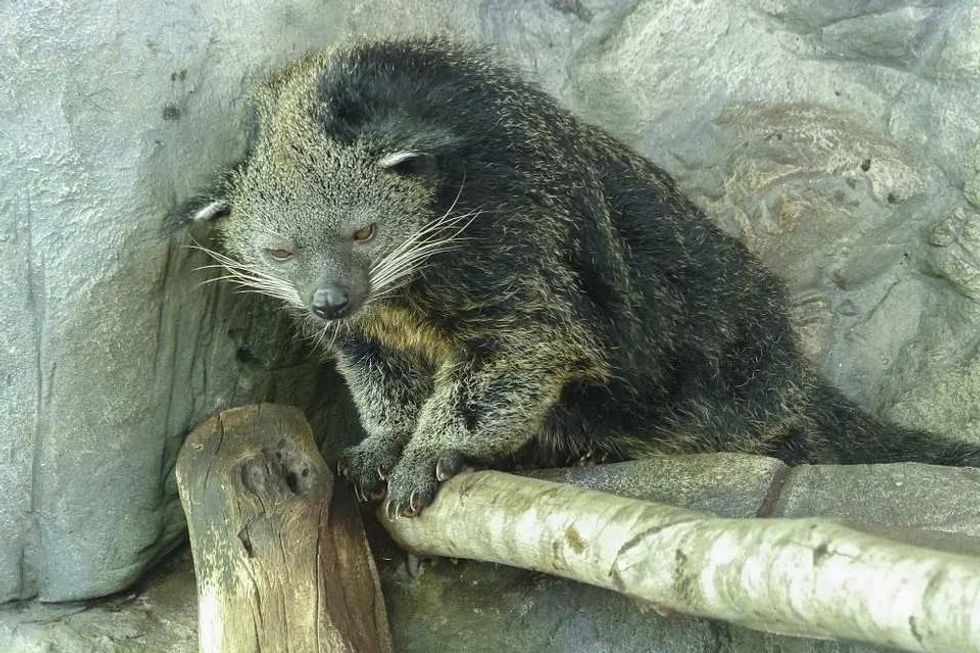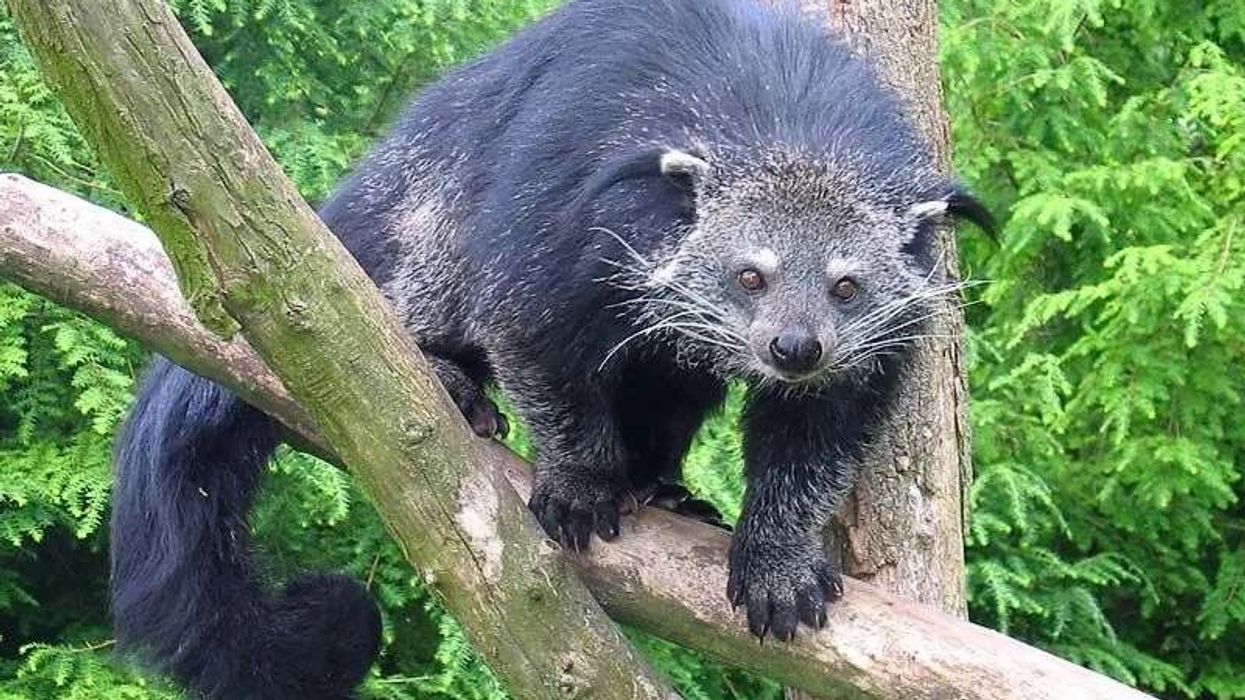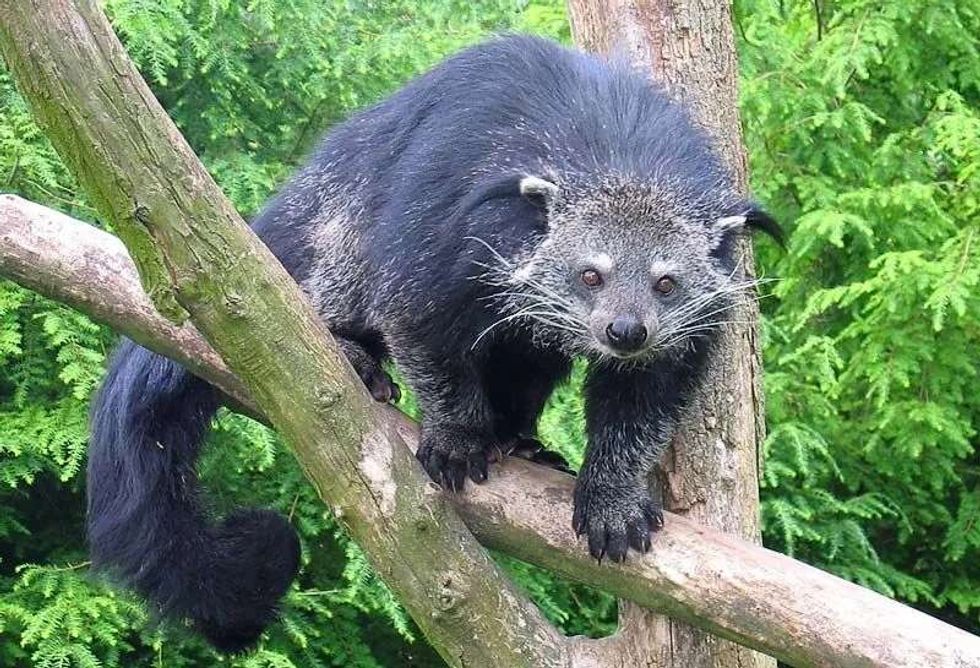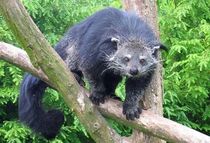Fun Binturong Facts For Kids
If you are a lover of animals in the wild, then you must already be eager to know more about the binturong. In this article, you will find all that there is to know about this bearcat animal.
The Arctictis binturong, also known as a bearcat, are medium-sized animals. They have a cat-like face while their body is like a bear.
They are omnivorous and eat fish, birds, small mammals, and fruits like the strangler fig. They can live for around 25 years in captive conditions.
Their numbers have been on the decline in the past 30 years due to habitat destruction, hunting, and wildlife trade. They have been included in the IUCN Red List of threatened species under the category: Vulnerable. Some scientists list binturong in the order of Carnivora, but they mostly eat fruit.
This bearcat animal will let out a high-pitched wail if they are unhappy. Binturong comes with a specific scent that is similar to buttered popcorn.
Experts have a tough time getting more information on this species since they are difficult to observe daily. In this article, you can find more information on binturong.
If you like this article about binturong facts, you may also want to check our other animal facts articles on squirrel monkeys and snowshoe hare.
Binturong Interesting Facts
What type of animal is a binturong?
The Arctictis binturong also known as a bearcat is a medium-sized animal of the Viverridae family and the order Carnivora. Civets, linsangs, and genets are also part of this family. They happen to be the sole occupants under the genus Arctictis.
What class of animal does a binturong belong to?
Binturong belongs to the class of Mammalia.
How many binturongs are there in the world?
There are 14 binturongs as of now in the Association of Zoos and Aquariums (AZA) care and 11 in other facilities all over the globe. They're currently classified as Vulnerable and their populations have been declining more than 30 percent over the past 30 years due to the hunting and pet trade.
They are also known for their meat and fur which are highly priced in markets. These factors have led to ridiculous poaching of this species giving them the conservation status of Vulnerable.
Where does a binturong live?
Arctictis are mostly found in dense, moist tropical forests and in areas that are close to water sources. They mostly settle near slow-moving water sources.
Binturongs stay in the forest canopy and generally tend to live at heights and are not known to come down from treetops very often. Binturongs prefer their solitude and hence, do not mingle much apart from with their own species.
Binturongs are also very shy and prefer staying confined in their own surroundings and hence are not considered exploratory animals. The binturong can both swim and dive properly. They like spending time in the water cooling themselves, especially when it's really sunny and hot outside.
This is somewhat similar to humans if you think about it. The Arctictis binturong has been most affected by habitat loss in Southeast Asia due to heavy deforestation and human intervention.
What is a binturong's habitat?
Binturongs commonly inhabit the southeastern region of Asia like China, India, Thailand, Cambodia, Laos, Malaysia, Indonesia, Sumatra, Kalimantan, and Java in Indonesia to Palawan in the Philippines.
Who do binturongs live with?
Binturongs live alone or in small groups of family. This includes a female binturong and her offspring. Binturongs are particularly introverted and do not socialize much often. Binturongs are calm creatures who prefer staying in small familiar circles and rarely get angry or involve themselves in fights with other species.
How long does a binturong live?
Binturongs are known to live up to the age of 25 years when kept under captivity with proper medical attention. Generally, they are at a lot of risk in the wild. Binturongs have been at risk of extensive poaching for their meat and skin.
They are also under threat from other wild predators. Many young ones from the litter are not able to survive in the wild.
This makes their life very short. In captivity, there are chances that they live up to their maximum lifespan of 25 years since they are well fed and looked after. Also, not having a constant fear of getting killed by the hunters or predators help their growth and overall health.
How do they reproduce?
Binturongs do not have a specific mating season and mate throughout the year but studies have shown most births occur between January and March. The female binturongs generally send signals to their male counterparts through purring.
After a gestation period of about 90 days, the females give birth to one to three offspring under favorable environmental conditions. It is the duty of the female binturong to look after the young ones and to protect and feed them. The males generally wander around to gather food.
The females of this species in the meanwhile train the young ones to live in the wild. Within a year the younger binturongs become independent to fend for themselves.
What is their conservation status?
Binturong is an animal that has been poached extensively for meat and fur. Binturong has been categorized as vulnerable in the IUCN Red List.
Binturong numbers have been on a heavy decline since the mid-1980. It is said that the binturong population has reduced by around 30 percent since then.
There are several organizations like the Association of Zoo and Aquarium that are working on preserving and promoting the growth of binturong. They are an important part of the ecosystem and also contribute to it because they assist in the germination of plants as they move around dense forest areas looking for food.
They spread fruit seeds via their feces and thus play a major role in helping in the replantation of the rainforest. They can also act well as pest control since they attack and prey on rodents.
Binturong Fun Facts
What do binturongs look like?
Binturongs are short stout creatures with shaggy black fur over their bodies. Their fur is white gray on the ends.
Their eyes are transparent and brown and look slightly bigger compared to their face size. They have small rounded ears which are short but they have long ear tufts. The major attraction on their facial features is the long stiff white whiskers that make them look like a cat.

How cute are they?
They have a face similar to the cat while the build of their body like a bear with shaggy black hair making them very appealing. Their cat-like appearance with stiff white whiskers and their long ear tufts give away a very sweet image.
They can be intimidating to look at, during the first phases. Their long ear and reddish-brown eyes can make them really lovely to look at. Their babies are especially very cute.
How do they communicate?
Binturongs make lots of noises to communicate like they chuckle and snort to express their happiness. They are known to send a high-pitched wail which resembles the screaming of a cat when they sense danger or get angry.
They hiss, howl, or even low grunts when bothered. The females also send signals to the males to express their desires by making purring sounds.
How big is a binturong?
The size and proper growth of animals are reflective of their good health. Binturongs are 30-36 in or 76-91 cm long generally when they are well fed and properly looked after.
The ones in the wild tend to be at a higher risk of not getting proper attention or none of it at all. The binturongs in captivity tend to grow more healthy as compared to the ones left in the wild.
How fast can a binturong run?
The binturong can speed around 15 mph. Their small body structure, as well as agile movements, makes them sprint for longer distances.
Their abilities to climb branches and stay on them keep them extremely active. Their speeds also help them to protect themselves from predators and hunters. They rarely come down on the ground and can climb from one tree to another in a blink of an eye making them extremely difficult to spot them.
How much does a binturong weigh?
A healthy adult binturong would weigh around 22-71 lb or 10-32 kg. The males are known to weigh more than the females of the species.
The weight of binturongs has a lot to do with their health and nutrition. The species in the wild can weigh low because of inadequate food supply and constant threat from predators.
The ones kept in captivity tend to flourish and weigh more because of adequate food supply and also proper medical treatments. They also feel a sense of security which improves their health further.
What are their male and female names of the species?
The scientific name of the species is Arctictis binturong but there are no specific names given to the male and female binturong.
What would you call a baby binturong?
These baby binturongs are also known as baby bearcats.
What do they eat?
Binturongs are omnivorous and have a mixed diet of fruits, leaves, birds, fish, and eggs. They also eat small insects, small invertebrates, earthworms, and rodents.
Binturongs do not have the attributes of a predator and thus mostly their diet includes fruits and vegetables. Strangler figs make up a major portion of their diet.
In captivity, they feed on different kinds of fruits like apples and bananas as well as biscuits, ground meat, carrots, yams, tomatoes, shoots, and leaves. The area where they stay, like the forest canopy, can provide them with such food variety.
Are they friendly?
Binturongs are extremely shy and like to live within small groups spending the majority of their time moving slowly and cautiously on the treetops. They are friendly in familiar scenarios but can be aggressive when they sense some danger around or are threatened or harmed.
Would they make a good pet?
Binturongs mainly belong to the zoos because they are playful with the visitors and have a good nature. They can lose their temper when they sense some threat around and also have sharp claws and teeth making them very dangerous around kids. They have retractable claws that make them excellent climbers.
When they are climbing down a tree, these claws can really help. These bear cats are not suitable as pets in domestic households. A binturong pet is not a common sight.
Did you know...
The binturong's tail is as long as its body. The binturong is one among the two carnivores gifted with a prehensile tail. A prehensile tail helps the animal to get a good grip when climbing tree branches and also over the objects they want to hold.
The kinkajou is the other species with a prehensile tail. Binturongs are also known to have the ability to turn their hind legs. This helps them in their motion on the trees.
Binturongs are one of only two species that also have enzymes that help them in making the seeds soft.
Binturongs even sleep high on tree branches. However, when they traverse to other trees, they climb down and move to the next tree.
In China and Vietnam, binturongs are considered a delicacy. Binturong body parts are used in some traditional medicines.
Why does a binturong smell like popcorn?
Binturong is an animal that smells like popcorn or like buttered popcorn! There is an oil gland beneath the tail of the binturong that causes this.
Wherever the Binturong goes, the place reeks of this smell. This becomes one of the ways to communicate within their species but then there is also the threat of predators and hunters as they can track the creature because of this smell.
Are binturongs canivores?
Binturong animal is an omnivore. Although some place them in the order Carnivora, they are primarily frugivorous which means fruit-eating creatures. This bear cat has been known to eat plant shoots, eggs, fruits, and small birds.
Here at Kidadl, we have carefully created lots of interesting family-friendly animal facts for everyone to discover! Learn more about some other mammals including marsupial, or fennec fox.
You can even occupy yourself at home by drawing one on our Binturong coloring pages.
We Want Your Photos!
More for You
See All
Bachelor of Arts specializing in Journalism and Mass Communication, Postgraduate Diploma in Sports Management

Moumita DuttaBachelor of Arts specializing in Journalism and Mass Communication, Postgraduate Diploma in Sports Management
A content writer and editor with a passion for sports, Moumita has honed her skills in producing compelling match reports and stories about sporting heroes. She holds a degree in Journalism and Mass Communication from the Indian Institute of Social Welfare and Business Management, Calcutta University, alongside a postgraduate diploma in Sports Management.
Disclaimer
1) Kidadl is independent and to make our service free to you the reader we are supported by advertising. We hope you love our recommendations for products and services! What we suggest is selected independently by the Kidadl team. If you purchase using the Buy Now button we may earn a small commission. This does not influence our choices. Prices are correct and items are available at the time the article was published but we cannot guarantee that on the time of reading. Please note that Kidadl is a participant in the Amazon Services LLC Associates Program, an affiliate advertising program designed to provide a means for sites to earn advertising fees by advertising and linking to Amazon. We also link to other websites, but are not responsible for their content.
2) At Kidadl, we strive to recommend the very best activities and events. We will always aim to give you accurate information at the date of publication - however, information does change, so it’s important you do your own research, double-check and make the decision that is right for your family. We recognise that not all activities and ideas are appropriate for all children and families or in all circumstances. Our recommended activities are based on age but these are a guide. We recommend that these ideas are used as inspiration, that ideas are undertaken with appropriate adult supervision, and that each adult uses their own discretion and knowledge of their children to consider the safety and suitability. Kidadl cannot accept liability for the execution of these ideas, and parental supervision is advised at all times, as safety is paramount. Anyone using the information provided by Kidadl does so at their own risk and we can not accept liability if things go wrong.
3) Because we are an educational resource, we have quotes and facts about a range of historical and modern figures. We do not endorse the actions of or rhetoric of all the people included in these collections, but we think they are important for growing minds to learn about under the guidance of parents or guardians.







